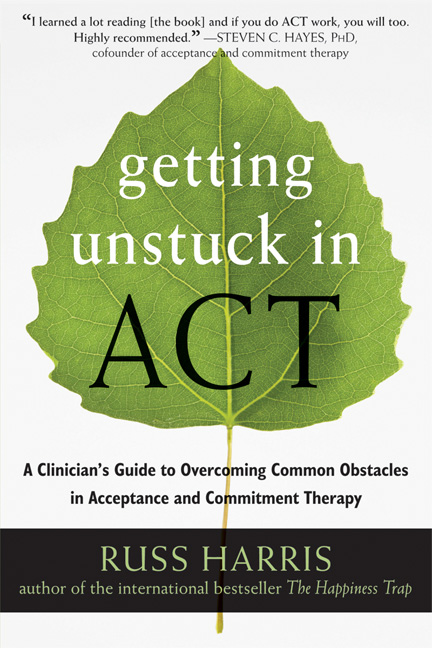The reluctant client comes in many different shapes and sizes. She may be legally mandated to attend therapy by a court of law, a medical insurance agency, or a government welfare agency. He may be coerced by a partner who threatens to leave him or a boss who threatens to fire him unless he “sorts himself out.” She may be pushed into it by well-meaning friends or relatives or by health professionals, such as her general practitioner. But whatever triggered the visit, one thing’s for sure: reluctant clients aren’t enthusiastic, willing, or open. If you’re a therapist, they aren’t looking to buy what you’re selling.
In his new book, Getting Unstuck in ACT: A Clinician’s Guide to Overcoming Common Obstacles in Acceptance and Commitment Therapy, world-renowned ACT trainer Russ Harris presents a four-step approach to selling ACT to reluctant clients, loosely based on the work of ACT pioneer Kelly Wilson. Harris specializes in working with adults, so keep in mind that these steps are not geared toward children or teenagers. If you’re an ACT therapist who works with youth and adolescents, you may find some valuable insight here, but use caution when considering these approaches for sessions with children and teens.
1. Empathize.
Begin by putting yourself in the client’s shoes. Say something like, “If I had been forced to come and see someone like me, I wouldn’t be too happy about it. Personally, I hate people telling me what to do. I think if I were sitting in your chair, I’d be really pissed off. So I’m wondering what you’re feeling right now.”
2. Normalize and validate.
Clients will respond to step 1 in a variety of ways. Some will use it as an opportunity to vent their frustration and anger. Some will go into denial. Some will take the opportunity to share how they feel. Whatever the client’s reaction, we normalize and validate it. For example, you might say, “That’s perfectly understandable. I think I’d be feeling pretty much the same way if our roles were reversed.”
For clients who claim they are fine, happy, or not bothered, try saying, “I have to admit that this surprises me a little. But, hey, we all respond in our own unique way to life’s challenges, and if this isn’t a hassle for you, that’s great.”
3. Declare your values.
Ideally, you’d preface step 3, declaring your values, with a bit of a disclaimer. You might say something like, “There’s something very important I want to say, and I don’t expect you to believe a word of it. In fact, I expect that when I share it with you, you’ll probably think I’m full of it. And that’s quite okay. You don’t have to believe it, but it’s important for me to say it.”
Then, declare your values, what motivates you to do this work. Say something like, “I do this sort of work because I really value helping people create better lives. So I’m not here for the court (or your boss, partner, employer). I’m actually here for you—to help you create a better life, however you define that. And I genuinely mean that. I’m not interested in what the court defines as a better life, but how you define it.”
If the client says, “You’re only here for the paycheck,” you could reply: “That’s a perfectly natural thought to have. And the truth is, yes, I do get paid for this work. But I’m not here only for the pay. I genuinely value helping people create better lives. And again, you don’t have to believe that. If you want to believe I’m only here for the money, that’s fine by me. The last thing I want to do is waste our time trying to convince you otherwise.”
4. Use the metaphor of the free will switch.
Finally, introduce the metaphor of the free will switch. Start out by saying: “Before we go any further, I’d like you to imagine something. Imagine that in front of you there’s a free will switch. When the switch is off, you’re here against your free will. You aren’t here for yourself, but only because the court (or your boss, partner, employer) forced you to come.
So with the free will switch off, being here is a total waste of your time. Sure, you get to placate or appease the people who sent you, but there’s nothing in it for you. You can use up the session time in lots of different ways—complaining about the people who sent you, getting angry with me, staring out the window, giving me one-word answers, or telling me the sorts of things you think I want to hear—but whatever you do, it’s pretty much just a big waste of your time.
However, if you turn the free will switch on, everything changes. The moment that switch goes on, you’re here for you—not for anyone else, but for yourself.
You’re here to use this time for your own benefit, to get something out of it that can make your life better in some way. Remember, my aim in this room is to help people live better lives. So the moment you turn that free will switch on, you’ll have all my resources at your disposal and we can work together to help you make your life better in some way. And by ‘better,’ I mean better as defined by you—not as defined by the court (or your boss, partner, employer). And here’s the thing: Whether you turn the switch on or leave it off doesn’t get you out of the session; it just determines whether being here is a total waste of your time or an opportunity for you to make a positive difference in your life. Of course, no one can force you to turn it on; it’s totally up to you. So, what do you want to do, turn it on or leave it off?”
See also: Using ACT to Get Through Tough Times
Most clients will agree to turn the switch on. If a client opts to leave it off, you could say something like “Fair enough. The thing is, I have no power to make you do anything against your will. The only way we can use this time effectively is if we work as a team, working together to help you build a better life. When the switch is off, it’s a waste not just of your time but also of mine. So maybe we should just end the session?”
At that point, the client will usually protest: “But I’ll go to jail (or my wife will leave me, my boss will fire me, I won’t get my kids back from child protection).” In response, you could reply, “Okay, so how about we put the switch on and make this work we do together about creating the sort of life where you aren’t in danger of going to jail (your boss isn’t threatening to fire you, your partner isn’t threatening to leave, your kids aren’t being taken into custody).”
The free will switch puts the agenda clearly on the table. There’s often little point in trying to work with someone who doesn’t want to be there. However, you may decide that it’s worth hanging in there, at least for a few sessions, even with the switch off. If so, you can still use the switch as a reference point. You might say, “Okay, we’ll keep going, and from time to time I’ll ask you to check in on that free will switch to see if it’s on or off. I think you’ll find that if and when you do switch it on, you’ll get much more out of the session. While it’s off, you’ll probably find our time together very draining.”
After that, if and when the client starts to engage, show interest, open up or contribute in some positive way, no matter how small is may be, do your best to positively reinforce that behavior, as we discussed in previous posts on the various ways to encourage workable behavior both during sessions and between sessions.
If you can get the switch on and the client agrees to an agenda of working together to build a better life, you’re off to a good start. You can also refer back to the free will switch whenever necessary. For example, if midsession the client starts staring out the window and giving one-word answers, you could say “It appears to me the free will switch just went off. What do you think?”
This four-step process isn’t a magic wand for each and every reluctant client, but it is very useful, and in you can, of course, modify and adapt it. From an ACT perspective, the therapist genuinely wants the client to live a richer, fuller life, whether he returns to work or not. The paradox is, as people get in touch with their values they often want to get back to work.
 For more on how to overcome the common roadblocks that pop up in ACT sessions, check out Russ Harris’s book, Getting Unstuck in ACT.
For more on how to overcome the common roadblocks that pop up in ACT sessions, check out Russ Harris’s book, Getting Unstuck in ACT.


 2024 Peace Playbook: 3 Tactics to Avoid Clashes with Your Partner
2024 Peace Playbook: 3 Tactics to Avoid Clashes with Your Partner